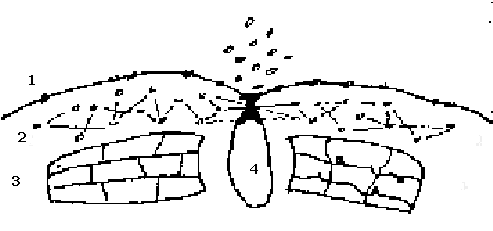The
diagram is a new informal dimension. It consists
in conceiving pure substances and functions, abstracting the forms in which they
incarnate. Substances not formed, not organized, functions not formalized. A functioning
abstracted of all obstacle, a cartography coextensive to the whole social field.
An abstract device defined by informal functions and substances, ignoring all
distinction of form.
To make marks randomly, zones, to spray ink in varied angles and speeds, recovering existing figurative elements. Diagram is a catastrophe, the introduction of a Saara. As if we moved from unit of measure, substituting figurative units for micrometric or cosmic units. Accidental, randomic, free strokes, disrupting optic organization. The diagram is the operating set of lines and zones, of an-significant and non-representative strokes and spots. The diagram operation is to introduce actual possibilities. Under the action of these marks, the visual ensemble will not be anymore an optic organization.
Every diagram is a space-time multiplicity. Unstable or floating, taking substances and functions to constitute mutations. It does not function to represent a preexisting world. It operates undoing given realities and significations, constituting unexpected conjunctures and improbable continuous.
Societies are a network of alliances, irreducible to a structure. Diagram is different from structure: the alliances weave a weak and transversal network, a strategy different from combination, forming unstable systems, in perpetual disequilibrium.
Diagram is a display of relations of forces: multi-punctured and diffuse relations. A density and intensity chart that proceeds through non-locatable articulations, passing the all the time through all the points. Presentation of the force relations inherent to a formation, the distribution of the power to affect and being affected, the arrangement of non-formalized functions and non-formed substances.
Power is diagrammatic: it mobilizes non-stratified substances and functions. It doesn’t pass through forms, but points, whose indicate the application of a force (action and reaction), an always local and unstable effect. The diagram is an emission: therefore the relations are mobile and non-locatable connections.
 |
|
The relations of power constitute a strategy, exercise of the non-stratified, therefore they escape from stable forms. The instability of the power relations defines a strategic field, non-stratified. This disjunction of forms is the place where the informal diagram happens. The concrete arrangements are therefore cut by the interstice through which the device is effectuated. The concrete arrangements (discontinuous, enclosed) communicate themselves in the abstract device, which confers them a soft and diffuse segmentation. A diagram is an overlapping of maps: along the points it connects, other points are free, points of creation and mutation.
The relations of force are only potential, unstable, while they do not enter in a macroscopic set that gives them form. An actualization happens through gradual integrations, local and later global. The relations of power end by being integrated (stratified) locally. How integration happens? Through the curve that matches the singular points. The diagram (emission of singularities) opposes to curve (that congregates them passing through the neighborhood). The curve regularizes and lines up in series the force relations. Two modes of fixing unstable force relations, to locate and globalize the diffusions: the frame and the curve, the two heterogeneous powers of formalization.
Historical structures oppose to power configurations, relations of forces in an informal and non-stratified element. The diagram is different from the stratum, formation that gives stability to it. The diagram always exists outside the stratum. There is no chaining through continuity, but over the ruptures and discontinuities.
Diagram sends to a outside that doesn’t have form, it aims at arriving at the non-stratified. It happens in the interstice, in the disjunction, under the intrusion of an outside that opens an interval. It is not the composition (stratified) that transforms, but the composition forces, related with other outside forces (strategies).
The world is made of overlapped surfaces, stratums. But the strata are crossed by a rupture, which distributes the frames and curves. The question is to pass over the stratums to reach outside, an atmospheric element, a non-stratified substance. This informal outside is as a turbulence zone, where agitate singular points and relations of force between them.
To each atmospheric state corresponds a diagram of forces: a strategy. The strategy is aerial or oceanic. The relations of informal forces actualize themselves in two heterogeneous forms, the curves and the frames. But they jump the rupture that separates them, integrating but also differentiating themselves.
